Citroën Visa
| Citroën Visa | |
|---|---|
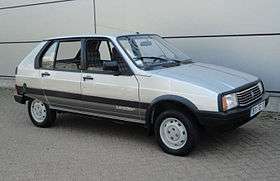 | |
| Overview | |
| Manufacturer | Citroën |
| Production |
1978–1988 1991–1994 (China) |
| Assembly |
France: Rennes (PSA Rennes Plant) Spain: Vigo (PSA Vigo Plant) |
| Body and chassis | |
| Class | Supermini (B) |
| Body style |
5-door hatchback 4-door cabriolet |
| Layout |
FF layout F4 layout |
| Related |
Citroën C15 Karenjy Visa (RM)[1] Wuling LZW 7100 (PRC)[2] Citroën Axel / Oltcit Club |
| Powertrain | |
| Engine |
652 cc flat-2 954 cc I4 1,124 cc I4 1,219 cc I4 1,360 cc I4 1,580 cc I4 1,769 cc diesel I4 |
| Dimensions | |
| Wheelbase | 2,436 mm (95.9 in) |
| Length | 3,690 mm (145.3 in) |
| Width | 1,530 mm (60.2 in) |
| Height | 1,410 mm (55.5 in) |
| Curb weight | 870 kg (1,920 lb) |
| Chronology | |
| Predecessor |
Citroën Ami Citroën Dyane |
| Successor | Citroën AX |
The Citroën Visa is a five-door, front-engine, front wheel drive supermini manufactured and marketed by Citroën from 1978 to 1988 in gasoline and diesel variants. 1,254,390 examples were ultimately manufactured over a single generation, with a single facelift (1981). China has also assembled the car as the Liuzhou Wuling LZW 7100 minicar. Production started in 1991 and finished in 1994.
The Visa was noted for its prominently articulated and tightly organized ergonomic driver control center—Citroën's answer to a proliferation of haphazardly located switches.
Citroën commissioned Heuliez to produce a Visa convertible variant, marketed as the Decapotable (1984), and a diesel box van variant (1985–2005) was marketed as the Citroën C15. A sedan variant was prototyped but never manufactured.
Development
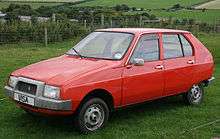
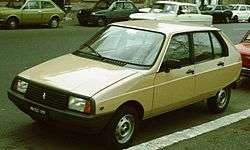
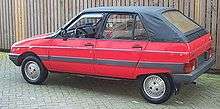
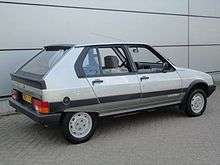
In 1965 Robert Opron began working on the Citroën G-mini prototype and project EN101, a replacement for the 2CV using its flat twin engine and intended to launch in 1970. The advanced space efficient designs with compact exterior dimensions and an aerodynamic drag co-efficient Cd of 0.32, were never fully developed because of negative feedback from potential clients.[3]
A subsequent program, the Citroën Prototype Y, was developed in the early 1970s in co-operation with Fiat, to replace the 2CV-based Citroën Ami — using lessons from the Citroën G-mini and EN101 projects. Prototype Y used the Fiat 127 platform with the pioneering transverse front-engine, front wheel drive layout Fiat had test-marketed in the Autobianchi Primula.
When cooperation with Fiat ended, Citroën designed its own platform, and subsequent to the takeover of Citroën by Peugeot in the wake of the 1974 oil crisis, the renamed "Projet VD (Voiture Diminuée)" became the Citroën Visa, incorporating the floor pan of the Peugeot 104 and using the 104 engine, transmission (under the engine) and chassis.[4] The Visa thus became the first model under PSA Peugeot Citroën's platform-sharing policy.
In 1984, the original Citroën platform design from "Project Y" emerged as the Romanian Oltcit Club, using a Citroën Visa flat-twin engine and Citroën GS based gearbox, and Citroën GS flat-four engine and gearbox — and marketed in Western Europe as the flat-four (only) Citroën Axel to recoup Citroën's Romanian investment, which the Romanian government could not repay. The resulting exhibited build quality issues, with 60,184 cars ultimately manufactured.
Model history and design
From its launch in September 1978,[5] the front-wheel drive Visa was available in "Spécial" and "Club" models with a mapped electronic ignition[6] (652 cc, 2-cylinder), and a "Super E" model (the 11RE after 1984), with the advanced Peugeot 1,124 cc Douvrin engine / PSA X engine, a four-cylinder "Suitcase engine" — all aluminium alloy, chain driven overhead cam, with gearbox in the sump, sharing engine oil, mounted almost on its side.[6] The 1124 cc was as economical as the Citroën 2CV-derived twin, but with much better performance. Later on it had 1,219 cc (Super X) and then 954 cc (10E after 1984) and 1,360 cc (1983 Visa GT and 14TRS after 1985) versions of the same engine.
The Visa featured a soft but well-damped, long-travel, fully independent suspension (Coil-sprung MacPherson struts at the front, with coil sprung trailing arms at the rear) that contributed to a soft ride[7] similar to the Citroën 2CV, but without extreme bodyroll.
In spring 1984 the diesel version was added. The Visa 17D and 17RD used the famously rugged and refined, class-leading 1,769 cc XUD diesel and transmission from the Peugeot 205. It had too wide a track for the original engine compartment and wings, so the front wings were extended with large black plastic wheel arch panels. The spare wheel that in smaller petrol engine versions, was mounted on top of the flat or near horizontal engine, was bolted to the otherwise flat boot floor — compromising luggage space. In continental Europe, a basic diesel van the 'Visa Enterprise' was sold that used the normal Visa bodyshell with the rear doors welded shut.[8] It mounted a spacesaver spare wheel under the bonnet, over the diesel engine.
At the Paris Salon 1984, for model year 1985, the 1.4 L TRS was presented.[9] The Visa 14 TRS, was produced for two years (1985–1987), shared its engine with the Citroën BX14 and receiving a favourable review by CAR magazine.[10]
Between 1985 and 1987 the 1.1 litre petrol and 1.7 litre diesel "Leader" special editions were marketed.[8] Near the end of its production life, a 55 PS (40 kW) catalyzed version of the 1,360 cc engine was added for markets with stricter emissions standards.[11]
No automatic gearbox version was produced.
Production of the Visa finished near the end of 1988, when the five-door version of the Citroen AX was launched.
Dashboard satellites and interior
The Visa driver controls were located in two pods flanking the steering wheel and were marketed as PRN Lunule (Satellites) (P=Pluie – Rain, R=Route – Road, N=Nuit – Night). Controls for wipers, washers, horn, indicators, headlamps and flashers were mounted ergonomically on a cylindrical unit with HVAC controls using laterally arcing sliders were located oppositely on a flat control pod — all within finger-tip reach.[6] In 1979 Popular Science described the system as using a "finger-tip control drum."[12]
In 1982 the Visa received a facelift, designed by Heuliez, retaining the original interior and "PRN Satellite" controls. In 1984 the Visa received a new dashboard, instruments and switchgear, retaining its monospoke steering wheel.
The curved sides of the Visa's windscreen enabled the use of a very large single wiper on the long narrow windscreen. The front of the revised car, was designed to aerodynamically reduce the deposition of dirt on the headlights, and to reduce the risk of stone chips to the headlights, bonnet and windscreen.
The Visa's heating and ventilation system, (even though it used only a water control valve for temperature control and not air mixing), could provide cold air from fascia side vents to the face while warming the car.[13] The central directable fascia vents could be heated and angled, so that they could be pointed directly at the windscreen in front of the driver, to keep it clear in extreme misting conditions. There was also an additional mid level vent, to blow air between the front seats to the back of the car.[13]
The Visa's rear parcel shelf was in two hinged sections, one in the car, the other on the tailgate, to allow objects that were slightly too tall to still fit without removing the shelf. When carrying larger loads, the part of the shelf attached to the tailgate could be folded up, and fixed with the elasticated support strings, to protect the rear window and heated rear screen elements.[13]
Visa convertible
Citroën commissioned a four-door convertible Visa from Heuliez in 1984. Marketed as the Visa Decapotable, the bodywork featured a hybrid fixed-profile convertible with the doors and window frames remaining intact. Based on the 11RE the convertible was heavier and slower than its hatchback counterpart.
Engines
| Engine Code | Engine Type | Cubic Capacity (cc) | Maximum Power | Maximum Torque |
|---|---|---|---|---|
| V06/630, V06/644, V06/665 | 2 cylinders (Boxer) | 652 | 35 PS (26 kW; 35 hp) at 5250 rpm | 48 N·m (35 lb·ft) at 3500 rpm |
| XV8 | 4 cylinders | 954 | 45 PS (33 kW; 44 hp) at 6000 rpm | 65 N·m (48 lb·ft) at 2750 rpm |
| XW7 | 4 cylinders | 1,124 | 50 PS (37 kW; 49 hp) at 5500 rpm | 83 N·m (61 lb·ft) at 2500 rpm |
| XZ5X | 4 cylinders | 1,219 | 64 PS (47 kW; 63 hp) at 6000 rpm | 91 N·m (67 lb·ft) at 3000 rpm |
| XY7 | 4 cylinders | 1,360 | 60 PS (44 kW; 59 hp) at 5000 rpm | 105 N·m (77 lb·ft) at 2500 rpm |
| XU5J | 4 cylinders | 1,580 | 115 PS (85 kW; 113 hp) at 6250 rpm | 131 N·m (97 lb·ft) at 4000 rpm |
| XUD7 | 4 cylinders diesel | 1,769 | 60 PS (44 kW; 59 hp) at 4600 rpm | 112 N·m (83 lb·ft) at 2000 rpm |
| Model
|
Engine | Displacement cc |
Fuelling | Power HP/rpm |
Torque Nm/rpm |
Drive | Standard Number Manual Gears |
Kerb Weight (kg) |
Speed max |
Acceler. 0–100 km/h (0-62 mph) |
Consum. (l/100 km) |
Production years |
Cooling |
|---|---|---|---|---|---|---|---|---|---|---|---|---|---|
| Petrol Versions | |||||||||||||
| Visa Special/Club/ Entreprise/base | V06 | 652 | Carburetor | 35/5250 | 49/3500 | FWD | M/4 | 745 | 128 | 29.3 | 5.4 | 1978-87 | Air |
| Visa 10E | XV | 954 | 45/6000 | 66/3000 | 810 | 133 | 19.8 | 6.6 | 1986-881 | Water | |||
| Visa Super/Super E/ L / 11 E/11 RE/Entreprise | XW7 | 1124 | 50/5500 | 84/2500 | 800 | 144 | 16.6 | 7.7 | 1978-88 | Water | |||
| Visa Cabriolet | 813 | 137 | 20.7 | 6.5 | 1983-85 | Water | |||||||
| Visa Super X | XZ7G | 1219 | 64/6000 | 91/3000 | 815 | 155 | 14.0 | 8.3 | 1980-82 | Water | |||
| Visa 14 TRS | XY7 | 1361 | 60/5000 | 105/2500 | 830 | 153 | 14.0 | 6.3 | 1985-87 | Water | |||
| Visa GT/Chrono2 | XY8 | 80/58003 | 108/2800 | M/5 | 830 | 168 | 10.9 | 7.3 | 1982-85 | Water | |||
| Visa Chrono4 | XYR | 93/5800 | 125/4500 | 850 | 173 | 10.2 | 8.5 | 1982 | Water | ||||
| Visa 1000 Pistes | - | 112/6800 | 131/4500 | AWD | 183 | 8.7 | 9 | 1983 | Water | ||||
| Visa GTi | XU5J | 1580 | Electronic Multi Port Injection | 105/6250 | 134/4000 | FWD | M/5 | 870 | 188 | 9.1 | 7.4 | 1985-86 | Water |
| XU5 JA/K | 115/6250 | 192 | 8.8 | 7.8 | 1986-88 | Water | |||||||
| Diesel Versions | |||||||||||||
| Visa 17 D/17 RD/ 17 D Entreprise | XUD7/K | 1769 | Naturally Aspirated Mechanical Indirect Injection | 60/4600 | 110/2000 | FWD | M/4 | 890 | 152 | 15.9 | 5.2 | 1984-88 | Water |
| Note: 1As early as 1984 in some markets 2It is understood the Chrono not solely intended to France and introduced in 1983 372 HP a 6000 revs/min for the cars for the Swiss market 44 Designed exclusively for the French market | |||||||||||||
Sport variants
The first sport variant of the Visa included the "Visa GT" (1.4 L with double-barrel carburettor and 80 hp (59 kW) DIN), the "Visa Chrono" (93 hp (68 kW) from the 1.4 L engine, this time with two double-barrel carbs). The Visa "Mille Pistes" (naturally aspirated 112 hp (82 kW) and four-wheel drive) was the rare production version of Citroën's successful (if unlikely looking) Group B Visa rally car, the Visa Chrono and Chrono II. The Mille Pistes was built in 200 examples in 1983 and received its name after a Visa 4 x 4 competing in the experimental category won this rally in 1983, with Wambergue and Laverne driving. The evolution models were modified by Denis Mathiot; the displacement was increased to 1440 cc and the resulting power ranged from 135 to 140 PS (99 to 103 kW), with the weight down to 750 kg (1,650 lb).[15]
At the Paris Salon 1984, for model year 1985, the high-performance 1.6 GTi was presented.[9] The GTi used the 1.6 L fuel injected XU5J engine and transmission combination (105 or 115 hp (77 or 85 kW) versions) from the successful Pininfarina styled Peugeot 205 GTI. Citroën gave the GTi plastic wheel arch extensions and quad round headlights, to differentiate the model and try to make it look more sporty. It received good reviews about its ride, performance and roadholding, but due to its older, failed facelift looks and its five-doors, even with a much lower price than the chic 205 it was not a big seller. There are now only a few GTi's left on the UKs roads and most are in storage waiting to be restored and returned to the road. There are currently just 17 GTi's known to the Citroën Car Club (UK) and The Citroën Visa Forum to survive and these are in various states of repair, with the vast majority of them being in long term storage.
References
- ↑ "Zébu roulant - Madagascar : une île en sursis - Blog LeMonde.fr". Madagascar.blog.lemonde.fr. 2010-03-24. Retrieved 2010-08-06.
- ↑ Par Joest Jonathan Ouaknine le 19 novembre 2007. "Un(e) Visa pour la Chine » » le blog auto: l'actualité automobile et sport automobile en temps réel". le blog auto. Retrieved 2010-08-06.
- ↑ Julian Marsh. "Citroën G-mini prototype and projet EN101". Citroenet.org.uk. Retrieved 2012-09-07.
- ↑ "Projet Y - Citroënet". Retrieved 2010-01-07.
- ↑ https://news.google.com/newspapers?id=SAI-AAAAIBAJ&sjid=cUkMAAAAIBAJ&pg=5910,4829885&dq=chrysler-horizon&hl=en
- 1 2 3 http://www.citroenet.org.uk/miscellaneous/autocar-visa/autocar-visa.html
- ↑ "Citroën Visa - Citroënet". Retrieved 2010-01-07.
- 1 2 "Visavision". Visavision.info. Retrieved 2011-09-28.
- 1 2 Büschi, Hans-Ulrich, ed. (March 5, 1987). Automobil Revue 1987 (in German and French). 82. Berne, Switzerland: Hallwag AG. p. 231. ISBN 3-444-00458-3.
- ↑ CAR magazine 1985
- ↑ Automobil Revue 1987, p. 232
- ↑ Michelle Higgins (January 1979). "What's New". Popular Science.
- 1 2 3 Citroën Visa Handbook
- ↑ "Citroën Visa and C15". Citroenvisa.net. Retrieved 2011-09-28.
- ↑ Tourneur, Henry (1983-11-24). "Citroën Visa en BX: vierwielaandrijving voor de kompetitie" [Four-wheel-drive for competition]. De AutoGids (in Flemish). Brussels, Belgium: Uitgeverij Auto-Magazine. 4 (109): 139.
External links
| Wikimedia Commons has media related to Citroën Visa. |
| Citroën car timeline, 1950s–1970s — next » | ||||||||||||||||||||||||||||||||||||||||
|---|---|---|---|---|---|---|---|---|---|---|---|---|---|---|---|---|---|---|---|---|---|---|---|---|---|---|---|---|---|---|---|---|---|---|---|---|---|---|---|---|
| Type | 1950s | 1960s | 1970s | |||||||||||||||||||||||||||||||||||||
| 0 | 1 | 2 | 3 | 4 | 5 | 6 | 7 | 8 | 9 | 0 | 1 | 2 | 3 | 4 | 5 | 6 | 7 | 8 | 9 | 0 | 1 | 2 | 3 | 4 | 5 | 6 | 7 | 8 | 9 | |||||||||||
| Economy car | 2CV | |||||||||||||||||||||||||||||||||||||||
| Bijou | ||||||||||||||||||||||||||||||||||||||||
| Off-roader | Méhari | |||||||||||||||||||||||||||||||||||||||
| Supermini | LN / LNA | |||||||||||||||||||||||||||||||||||||||
| Dyane | ||||||||||||||||||||||||||||||||||||||||
| Ami | Visa | |||||||||||||||||||||||||||||||||||||||
| Small family car | GS | |||||||||||||||||||||||||||||||||||||||
| Large family car | 11 CV | ID / DSpécial / DSuper | ||||||||||||||||||||||||||||||||||||||
| Executive car | 15 CV | DS | CX | |||||||||||||||||||||||||||||||||||||
| Grand tourer | SM | |||||||||||||||||||||||||||||||||||||||
| « previous — Citroën car timeline, 1980s–present | ||||||||||||||||||||||||||||||||||||||
|---|---|---|---|---|---|---|---|---|---|---|---|---|---|---|---|---|---|---|---|---|---|---|---|---|---|---|---|---|---|---|---|---|---|---|---|---|---|---|
| Type | 1980s | 1990s | 2000s | 2010s | ||||||||||||||||||||||||||||||||||
| 0 | 1 | 2 | 3 | 4 | 5 | 6 | 7 | 8 | 9 | 0 | 1 | 2 | 3 | 4 | 5 | 6 | 7 | 8 | 9 | 0 | 1 | 2 | 3 | 4 | 5 | 6 | 7 | 8 | 9 | 0 | 1 | 2 | 3 | 4 | 5 | 6 | 7 | |
| Economy car | 2CV | |||||||||||||||||||||||||||||||||||||
| Off-roader | Méhari | |||||||||||||||||||||||||||||||||||||
| City car | C1 I | C1 II | ||||||||||||||||||||||||||||||||||||
| Supermini | LN / LNA | AX | ||||||||||||||||||||||||||||||||||||
| Dyane | Axel | Saxo | C2 | DS3 | ||||||||||||||||||||||||||||||||||
| Visa | C3 I | C3 II | C3 III | |||||||||||||||||||||||||||||||||||
| Small family car | GSA | ZX | Xsara | C4 I | C4 II | |||||||||||||||||||||||||||||||||
| C-Elysée | ||||||||||||||||||||||||||||||||||||||
| DS4 | ||||||||||||||||||||||||||||||||||||||
| Large family car | BX | Xantia | C5 I | C5 II | ||||||||||||||||||||||||||||||||||
| DS5 | ||||||||||||||||||||||||||||||||||||||
| Executive car | CX | XM | C6 | |||||||||||||||||||||||||||||||||||
| Convertible | Visa cabriolet | C3 Pluriel | E-Méhari | |||||||||||||||||||||||||||||||||||
| Mini MPV | Nemo Multispace | |||||||||||||||||||||||||||||||||||||
| Compact MPV | Xsara Picasso | C3 Picasso | ||||||||||||||||||||||||||||||||||||
| C4 Picasso I | C4 Picasso II | |||||||||||||||||||||||||||||||||||||
| Large MPV | Evasion | C8 | ||||||||||||||||||||||||||||||||||||
| Mini crossover | C4 Cactus | |||||||||||||||||||||||||||||||||||||
| Crossover SUV | C-Crosser | C4 Aircross | ||||||||||||||||||||||||||||||||||||
| LAV | Acadiane | C15 | Nemo | |||||||||||||||||||||||||||||||||||
| Berlingo | Berlingo II | |||||||||||||||||||||||||||||||||||||
| Van | H Van | C25 | Jumpy I | Jumpy II | Space Tourer | |||||||||||||||||||||||||||||||||
| C35 | Jumper I | Jumper II | ||||||||||||||||||||||||||||||||||||